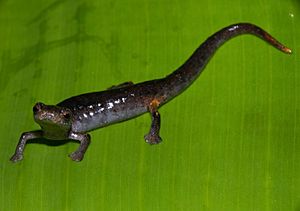Medellin climbing salamander facts for kids
Quick facts for kids Medellin climbing salamander |
|
|---|---|
 |
|
| Conservation status | |
| Scientific classification |
The Medellin climbing salamander (Bolitoglossa phalarosoma) is a special type of salamander. It belongs to a group called Plethodontidae, which are known as "lungless salamanders." This means they don't have lungs like humans or other animals. Instead, they breathe through their skin and the lining of their mouths!
These interesting creatures are found in two countries: Colombia and Panama. They like to live in specific places, usually in forests that are warm, wet, and high up in the mountains.
Contents
What is a Medellin Climbing Salamander?
The Medellin climbing salamander gets its name from the city of Medellin in Colombia, even though it lives in wild areas. It's a type of amphibian, just like frogs and toads. Amphibians are animals that can live both on land and in water, though salamanders usually prefer moist land.
This salamander is part of the Bolitoglossa group. These salamanders are known for their ability to climb. They have special feet that help them grip onto surfaces, like tree branches and leaves, making them excellent climbers in their forest homes.
Where Do They Live?
The natural home, or habitat, of the Medellin climbing salamander is in subtropical or tropical moist montane forests. Let's break that down:
- Subtropical or tropical: This means the areas are warm all year round, without cold winters.
- Moist: These forests get a lot of rain, making them very humid and wet. This is important because salamanders need moisture to breathe through their skin.
- Montane: This means the forests are found in mountains or hilly areas. The salamanders live at higher elevations where it's often misty and cool, even though it's a tropical region.
These forests are full of tall trees, thick plants, and lots of hidden spots where salamanders can find food and stay safe.
Why Are They Important?
Every animal plays a role in its ecosystem, and the Medellin climbing salamander is no different. As a predator, it helps control insect populations. As prey, it provides food for other animals. Its presence also tells scientists about the health of the forest. If salamanders are doing well, it often means the forest is healthy too.
What Threats Do They Face?
Sadly, the Medellin climbing salamander is facing challenges. It is currently listed as "Near Threatened" (NT) by the IUCN (International Union for Conservation of Nature). This means it could become endangered in the future if things don't change.
The biggest threat to this salamander is habitat loss. This happens when the places where they live are destroyed or changed by human activities.
- Deforestation: Forests are cut down for farming, logging, or building new towns and roads. When trees are removed, the salamanders lose their homes, food sources, and the moist environment they need to survive.
- Climate change: Changes in weather patterns can make their habitats too dry or too hot, which is dangerous for amphibians that need moisture.
Protecting these unique forests is key to helping the Medellin climbing salamander and many other animals that call these places home.
See also
 In Spanish: Bolitoglossa phalarosoma para niños
In Spanish: Bolitoglossa phalarosoma para niños


